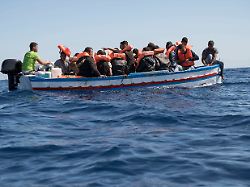Payment according to the migration pact
Tunisia should use EU millions to keep refugees out
September 22, 2023, 7:23 p.m
More and more people are applying for asylum in the EU. North African Tunisia is now receiving 127 million euros from Brussels. Around half of the money will be used to stem the flow of refugees across the Mediterranean. The EU also expects this to ease tensions on Lampedusa.
The EU Commission wants to pay Tunisia around 127 million euros to reduce migration via the North African country and stimulate the weakening economy. Around 67 million euros of this are to be made available in connection with a controversial migration agreement between the EU Commission and Tunisia, as a spokeswoman for the Brussels authority announced. There is also 60 million euros in budget support so that the country can recover from the Corona crisis. Tunisia is one of the main transit countries for refugees from Africa heading to Europe.
Part of the 67 million euros falls under the package of almost 105 million euros announced in June for new ships and thermal cameras, search and rescue operations, measures against smugglers and the repatriation of refugees. In return for the millions in financial aid, the Tunisian security authorities should in future take greater action against smugglers and the abandonment of boats.
Migration pact is controversial
The EU Commission received a lot of criticism for this so-called declaration of intent because the Tunisian government was accused of human rights violations. President Kais Saied announced tougher action against migrants in February, accusing them of bringing violence into the country.
Meanwhile, the number of first-time asylum applications in the EU rose significantly in June compared to the same month last year. As the statistics office Eurostat announced, 83,385 people applied for asylum in June, 25 percent more than in the same month of 2022. As in the previous months, people from Syria, Afghanistan, Venezuela and Colombia submitted the most applications. 75 percent of all applications for protection came from Germany, Spain, France and Italy. In relation to the population, most asylum applications were made in Cyprus and Austria.
The situation on Lampedusa should improve
A spokeswoman for the EU Commission said the financial aid to Tunisia should also help improve the situation on the Italian island of Lampedusa. Most refugees currently arriving in Lampedusa start in Tunisia. Lampedusa lies between Sicily and North Africa and has been one of the hotspots of migration to Europe for years: Last week, thousands of migrants landed there again on boats from North Africa – more than 5,000 in a single day. The authorities declared a state of emergency.
At the weekend, Italy’s Prime Minister Giorgia Meloni visited the island together with EU Commission President Ursula von der Leyen. Von der Leyen announced a ten-point plan there, which included greater surveillance of the Mediterranean and better training for the Tunisian coast guard. She also appealed to other EU states to voluntarily accept migrants from Italy.
However, the EU states have not yet managed to pass a comprehensive reform of the European asylum system. A compromise was reached in June, according to which asylum procedures should be significantly tightened. But an agreement with the EU Parliament is still needed.
